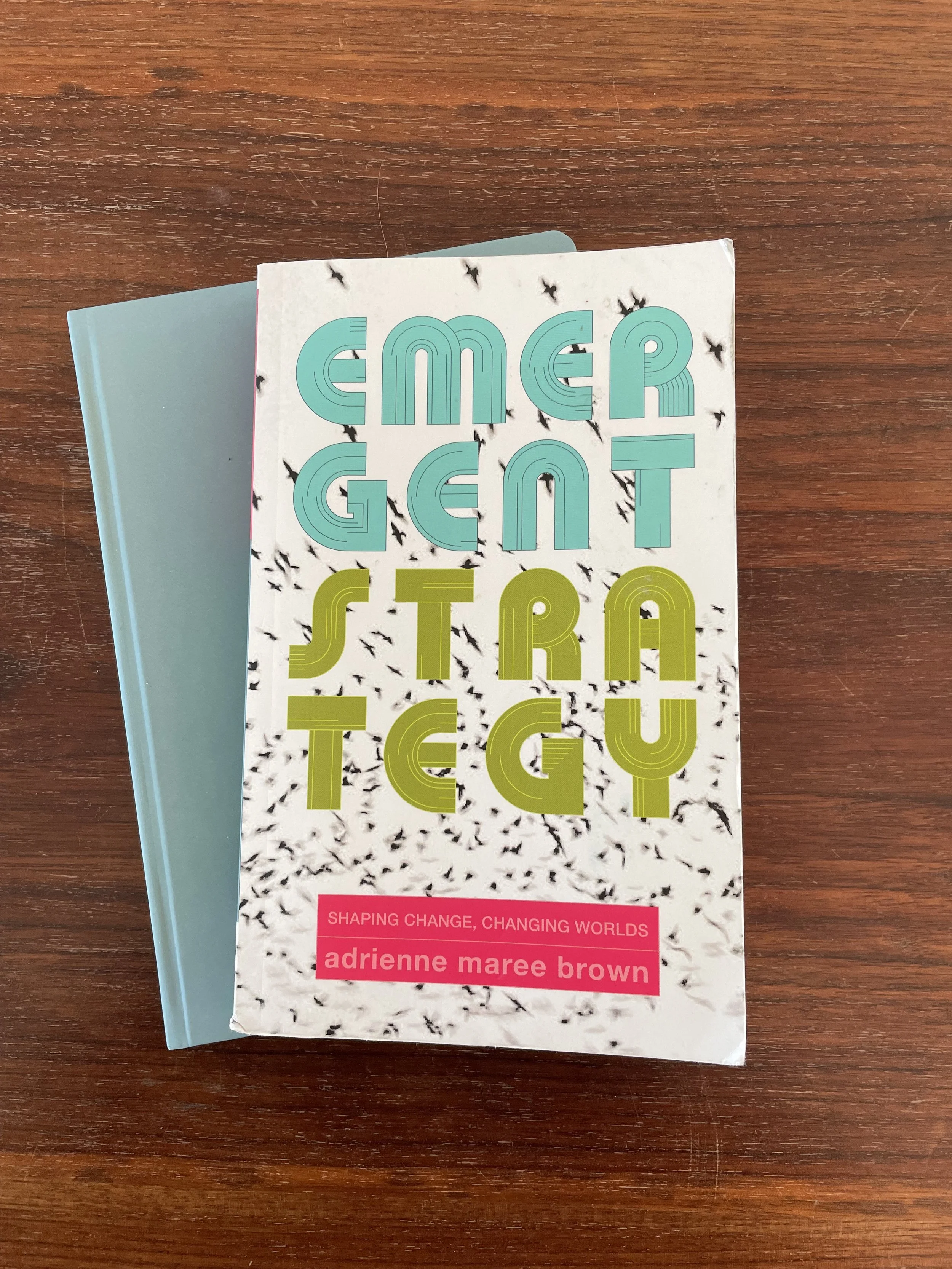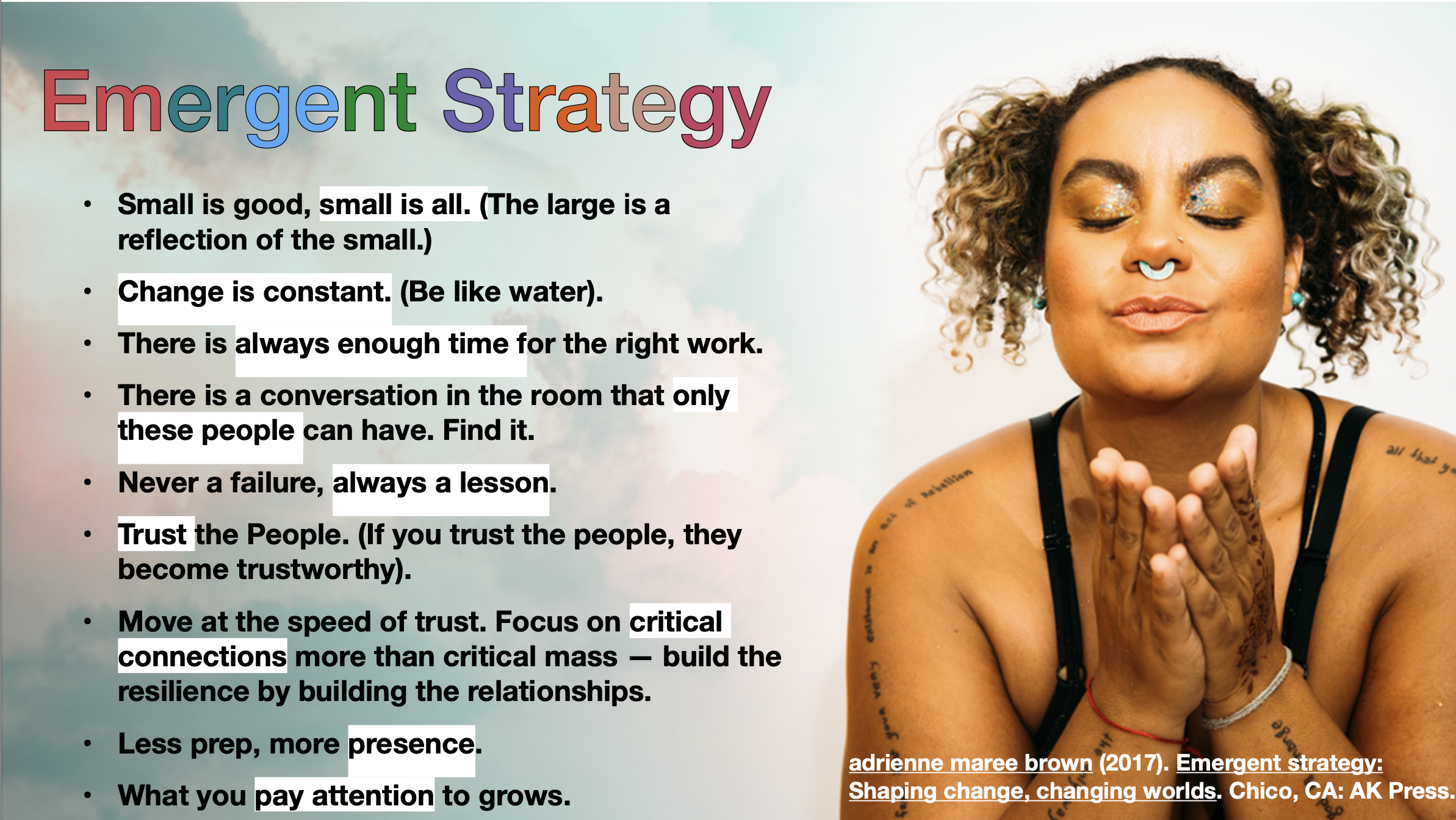I found Emergent Strategy right on time.
For the past year, I have used adrienne maree brown’s (2017) book, Emergent Strategy, as my “methods consultant” while facilitating an ongoing data equity project with several college campuses in Ohio.
Here is the description of the book from the publisher’s webpage:
“Inspired by Octavia Butler's explorations of our human relationship to change, Emergent Strategy is radical self-help, society-help, and planet-help designed to shape the futures we want to live. Change is constant. The world is in a continual state of flux. It is a stream of ever-mutating, emergent patterns. Rather than steel ourselves against such change, this book invites us to feel, map, assess, and learn from the swirling patterns around us in order to better understand and influence them as they happen. This is a resolutely materialist “spirituality” based equally on science and science fiction, a visionary incantation to transform that which ultimately transforms us.”
This book is published by AK Press, who are: “Worker-run. Collectively-managed. Anarchist publishing and distribution since 1990.”
I was curious about and initially uncomfortable with the word choice “anarchist.”But, after thoughtfully reading this description of how they run their press, I have deep respect for the self-described propagandist publishers at AK Press who print books to agitate and provoke.
We need to be provoked.
Emergent Strategy is similar to complexity theory and not unlike developmental evaluation and effectual thinking, which have informed the way I practice evaluation consultation. The cover art features flocking birds, which is the classic example of complex systems or complex adaptive systems.
brown says this about Emergent Strategy:
“A way of describing the adaptive and relational leadership model found in the work of Black science fiction writer Octavia Butler
Plans of action, personal practice, collective organizing tools that account for constant change and rely on the strength of relationship for adaptation
Strategies for organizers building movements for justice and liberation that leverage relatively simple interactions to create complex patterns, systems, and transformations
Ways for humans to practice being in right relationship to our home and each other, to practice complexity, and grow a compelling future together through relatively simple interactions”
In my life, I found Emergent Strategy at a time when a project was not going as planned.
During the summer of 2021, we began enrolling twelve Ohio campuses to use methods of collaborative inquiry to create more equitable conditions for groups that have historically been marginalized on campus.
Collaborative inquiry is a methodological approach that developed in the context of educational settings, and is a paradigm for adult learning through shared research.
As shown in Table 3.1 from Bray, Lee, Smith & Yorks (2000), Collaborative Inquiry In Practice, the ideal number for a collaborative inquiry group is five to twelve.
We invited over 80 campuses to participate in this project. And had conversations with tens of interested folks. By end of the summer, one campus had enrolled in our data equity project.
Then, two. And ultimately three.
But not five. Or twelve.
As we began planning our first Cohort 1 meeting, I could not get past the introductory chapters in my guide for putting collaborative inquiry into practice. After reading this passage about “Initiating the Inquiry Through Conferring With Others” repeatedly, I was sensing that we did not have the necessary inputs/ pre-conditions for collaborative inquiry.
Like, we had not passed the first test:
“The first test is the process of initiating and informing. Forming a collaborative inquiry group requires a substantial commitment of time and energy. […] The initiators’ action of inviting others to participate in an inquiry represents a dual test — the extent to which the general topic of concern resonates with the experience of others and the appeal of engaging in this form of inquiry.” Bray, Lee, Smith, Yorks (2000), p. 53
Three campuses were committed to applying an anti-oppression lens to their annual data collection and action planning activities. That was something.
What though?
Not enough for the collaborative inquiry I had envisioned.
It just so happened that my summer reading included a signed copy of Emergent Strategy.
Changing everything.
Yup. Even my proposed methodology.
In putting her pen to the first page of the book in my hands, the author adrienne maree brown gave me permission to let go of the words written into the project proposal. I embraced “small is all” and allowed myself to “be like water.”
I set aside my collaborative inquiry books, and the principles of Emergent Strategy became the guiding statements for our project.
Our early Cohort meetings were each inspired by one or more Emergent Strategy principles. The first meeting was all about principle four, finding the conversation in the room for only these people who had joined Cohort 1.
These people.
After weeks of worrying about getting campuses to enroll, I cannot say how good it felt to Trust the People, and to move at the speed of trust.
Our second meeting started with an examination of the last principle: What you pay attention to grows. This statement is similar to one often used by evaluators: what gets measured, gets done.
We focused our surveys and data-to-action processes on growing positive experiences for priority groups instead of identifying harm done to marginalized groups. Rather than asking a series of detailed questions about discrimination, micro-aggressions, or other hate/bias incidents, we paid attention to questions that would affirm diverse identities, measure sense of belonging, and document community resilience.
Emergent strategy is oriented towards shaping change. This position stands in contrast to our originally-proposed methodology of collaborative inquiry, which was designed to produce knowledge.
The distinction between change and knowledge is important in the primary prevention of sexual violence.
Public health practitioners and preventionists have long known that we cannot simply “train away” community health problems. For example, even when smokers fully understood what cigarettes can do to their body — that smoking can literally kill them — that knowledge didn’t necessarily lead to behavior change.
Increasing knowledge is not sufficient to create social/community change.
So moving, like water, from:
…a methodology developed by mostly straight white academics inside the context of educational settings to produce knowledge (i.e., collaborative inquiry)
to:
…an approach grounded in the lived experiences of a queer multi-racial pleasure activist working to mediate conflict within social change movements (i.e., emergent strategy)
felt really consistent with our intent to do something different than the status quo.
Emergent Strategy has helped me to work on myself, loosening the grip of internalized white supremacy on the way I am in relationships with others doing this work.
Look at this list from dRworks of the ways that white supremacy culture shows up in our organizations, in our homes, and in our heads.
Perfectionism
Sense of urgency
Defensiveness
Quantity over quality
Worship of the written word
Only one right way
Paternalism
Either / or thinking
Power hoarding
Fear of open conflict
Individualism
I’m the only one
Progress is bigger, more
Objectivity
Right to comfort
Many of these characteristics are deeply entrenched in academic, research, and scientific settings; and I try to stay vigilant about minimizing the ways that I reinforce these characteristics in the way I practice evaluation and data-to-action work.
Noticing and resisting white supremacy culture takes daily effort, and Emergent Strategy provides the counter-weighted mindsets and mantras I need.
As we move into the second year of this project, I have purchased another book to deepen my understanding/practice of Emergent Strategy.
I look forward to what I will find in its pages.
















